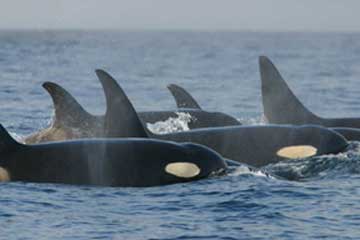 I won’t lie. My inspiration for this post is my obsession with this season’s Top Chef, set in Seattle, WA (Bye, Kristen! I was very sad you went home). Anyway, here is a list of some captivating facts about the dominating marine mammal (the last one is the most important!).
I won’t lie. My inspiration for this post is my obsession with this season’s Top Chef, set in Seattle, WA (Bye, Kristen! I was very sad you went home). Anyway, here is a list of some captivating facts about the dominating marine mammal (the last one is the most important!).
- The killer whale, or orca, is a toothed whale and a kind of dolphin – in fact, it’s the largest of all the dolphins!
- Their Latin name, Orcinus orca, means ‘Greek god of the underworld’.
- Male orcas can average up to 22 feet in length and can average up to 12,000 pounds.
- Female orcas can average up to 19 feet in length and can average up to 8,000 pounds.
- Newborn orcas average up to 8 feet in length and weigh up to 400 pounds.
- Orcas typically swim to speeds of 3 to 4 miles per hour, but can reach speeds of 30 miles per hour.
- Female orcas give birth on average every three years after age 13. Some may average giving birth every ten years.
- The dorsal fin of the male orca is the tallest of all the whales! It can be up to 6 feet high. Their dorsal fin will not be at full height until 12-20 years.
- Female orcas live to be 90 years old, while male orcas live to be about about 50 years.
- Orcas are known for excellent eyesight above and below the surface of the water.
- Orcas are common to the Arctic and Antarctic waters, but are found in every ocean around the world.
- Orcas eat up to 500 pounds of prey (e.g., fish, walruses, seals, sea lions, penguins, squid, sea turtles, sharks, as well as other types of whales) a day. They live and hunt in cooperative and playful pods forming packs – they’ve even picked up the nickname ‘wolves of the sea’.
- Orcas do not chew their food. They use their teeth for ripping and tearing prey, but most often swallow their prey whole. Their teeth are up to 3 inches long!
- Orcas have a gray area behind their dorsal fin, known as the ‘saddle patch’, that are unique to each whale.
- There are only 86 orcas left in the Pacific Northwest’ Puget Sound population. This population is threatened with extinction due to pollution, climate change and food shortages. You can sign a petition with Change.org to help keep orcas on the Endangered Species Act (Well, you can sign until January 27, 2013).
I am sure I missed many interesting details in this “Sink your teeth into this” post. Please feel free to add your favorite below or you can learn more here.
Image (c) nmfs.noaa.gov








What people are saying …